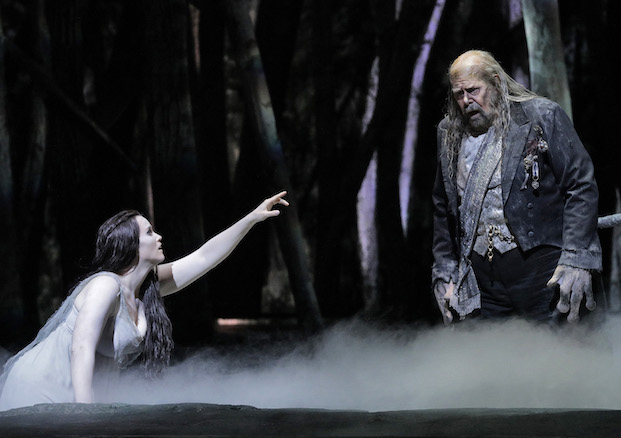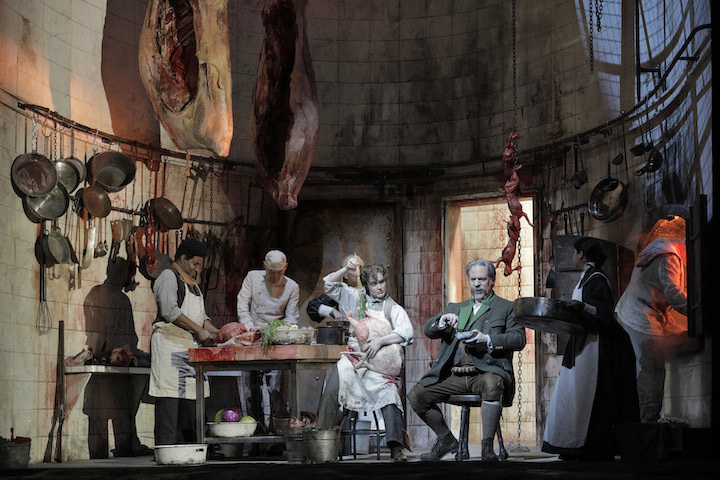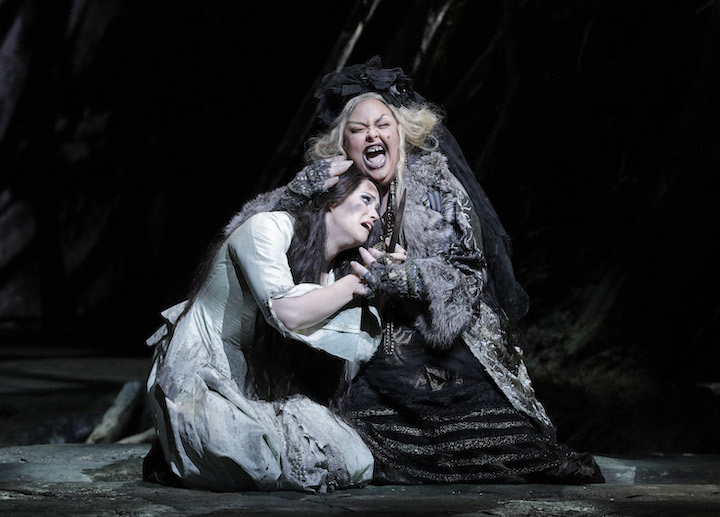Is it something about the northern cold of Scotland that makes its children comfortable in the world of dark elementals? Certainly production lead David MacVicar and set designer John Macfarlane, both Scottish, conjure up a natural world laced with mystery, grief and magic in their production of Dvořák’s Rusalka, which premiered at Chicago Lyric Opera in 2014 and is now at San Francisco Opera.
And what an enticing and gorgeous world it is. Dvořák’s fairy tale opera, using librettist Jaroslav Kvapil’s interpretation Czech folkloric stories, contains many of the motifs that appear in Hans Christian Andersen’s story of “The Little Mermaid.” Although Andersen’s mermaid is promised a salvation of sorts with her death, Rusalka’s fate is far darker and more demonic. But the opera production also provides a lightness as evanescent as light on water. The revival direction was by Leah Hausman.

The opera opens in forest dense with tall trees. Wood nymphs cavort around a woodland pool. Hair tangled and dressed in tattered tulle skirts, ankle-high boots and long knickers, they take the stage in high manic style, wagging their bottoms and rolling hither and thither. These are naughty sprites, and their game is to tease the Water Goblin Vodnik out of his wet kingdom. Bass-baritone Kristinn Sigmudsson as the Goblin, sporting long froggy fingers and flippers on his feet, is happy to oblige as he rises from the water impressive in stature and voice. Moritz Junge designed the sultry and playful costumes.
The original choreography was by Andrew George and the movement of the sprites mimics, here and there, fragments from the world of 19th-century ballet, which was given over to ethereal feminine spirits and the longings of dead girls forsaken by their lovers, both trapped in the natural world. This parody appears again in the opera’s second-act ballet, when dancers dressed in the classical tutus and fairy wings of Les Sylphides arrive to entertain the guests at the engagement party of Rusalka and the Prince. Like the wood nymphs there is a hectic and comic quality to their ballet, which enacts the soon-to-be-revealed faithlessness of the Prince.
After the wood nymphs dash away leaving the Water Goblin like an empty bottle, his daughter Rusalka appears. She has fallen in love with a human and wants to sacrifice her enduring elemental form on the altar of human love. After failing to convince her that this is a terrible mistake, her father leaves in despair. This leads to the most iconic moment in the opera, when Rusalka alone in the forest sings to the moon. Soprano Rachel Willis-Sørensen sang this beautiful aria with uncanny warmth. And as she did the trees of the forest moved slowly across the stage to reveal an enormous and luminous moon. It was a truly enchanting moment, and it was aided by the orchestra under the baton of Eun Sun Kim. How wonderful to see a young woman on the podium! Throughout the production the music was splendidly conducted by Maestra Kim, who kept instrumentalists and singers floating deftly through Dvořák’s romantic score.
Brandon Jovanovich sang the role of the Prince with dignity, precision and just enough confusion of sexual desire. Once he had carried Rusalka off to his castle the scene shifted to the narrow confines of the castle. Here the Gamekeeper (Philip Horst) and a Kitchen Boy (Laura Krumm) revealed through gossip the fear that Rusalka evokes in the human world. For Rusalka has given up her voice to become human, and although she appears to be a woman, the humans around her sense her preternatural origins, her chilly otherness. While singing of Rusalka, the Kitchen Boy pulled the innards out of an enormous featherless and dead swan. Nature won’t fare well between these castle walls.

It is the comic features of this production that tie the opera into the world of fairy tale and separate it from melancholic romanticism. Comedy allows for a particular form of grotesqueness and exaggeration that exorcises the maudlin and the sentimental that hover over romantic opera. Perhaps no one hit this note more perfectly than mezzo-soprano Jamie Barton in the role of the witch Ježibaba.
With a troupe of three outsized ravens as her familiars, Ježibaba is the witch who will give Rusalka human form in exchange for the transparent veil of her being as a wave and, more crucially, her voice. Barton not only has a powerful and compelling voice she has a brilliant comedic talent, with split-second timing and a range of deliberate awfulness. Her Ježibaba wavers from bad-tempered to gleefully malignant. And as she tells Rusalka, if the mermaid fails to gain her Prince’s love, then both Rusalka and he will suffer for eternity.

The details of the ending I leave for you to discover. This is a terrific production of a stunning opera. Terrific music, terrific singers, terrific staging. The audience went wild with pleasure. So go, if you can.
– Jaime Robles
San Francisco Opera’s production of Dvořák’s Rusalka continues through June 28. For tickets and information, visit sfopera.com.
